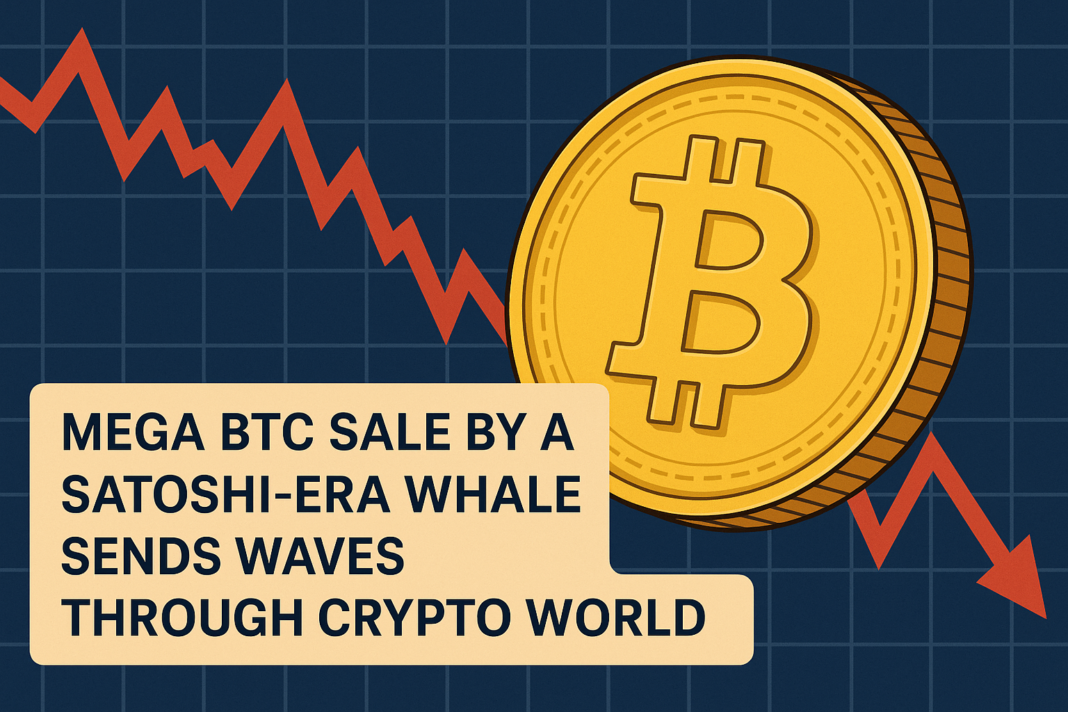Three Quick Takeaways:
- A long-dormant Bitcoin whale from the Satoshi era just sold a huge chunk of BTC, causing ripples in the market.
- The sale triggered fear of more old wallets waking up, but it’s not a reason to panic.
- It’s a reminder that Bitcoin’s early believers are still out there—and some are finally cashing in.
So, imagine this: you open your crypto tracker, and suddenly there’s this massive movement of Bitcoin—like, hundreds of millions of dollars worth—all coming from a wallet that’s been silent for more than a decade. No tweets, no leaks, no warning. That’s exactly what happened this week when a so-called Satoshi-era whale—someone who mined or bought Bitcoin back in its earliest days—decided it was finally time to cash in.
This isn’t just any old selloff. We’re talking about a wallet that hadn’t moved a single satoshi since around 2010. That’s when Bitcoin was still mostly used by early tech nerds, libertarians, and maybe a few Silk Road shoppers. Back then, BTC was worth less than a dollar. Now? That same stash is easily worth over $100 million.
What’s a Satoshi-Era Whale, Anyway?
If you’re new to the crypto space, “Satoshi-era” refers to the period when Bitcoin’s mysterious creator, Satoshi Nakamoto, was still active online—roughly between 2008 and 2011. Anyone who mined Bitcoin back then likely did so with a basic laptop and earned 50 BTC per block. No fancy rigs, no wild energy bills.
A “whale” is just a big holder. So when you hear “Satoshi-era whale”, think of someone sitting on a gold mine of Bitcoin, untouched for over a decade. They’re kind of like digital time travellers — logging back in after 14 years to find out they’re suddenly multimillionaires.
Why Did This Sale Rattle the Market?
The timing and scale were kind of wild. This wasn’t just a few BTC sent to an exchange. The wallet moved over 1,000 BTC, split across several addresses, and then sold a huge chunk through what looks like over-the-counter (OTC) deals to avoid crashing the open market.
But even so, word travels fast. When on-chain sleuths spot this kind of whale activity, people get nervous. What if this is just the beginning? What if more ancient wallets start waking up? The fear is that a big flood of coins could crush the price. And with Bitcoin already a bit shaky due to global economic tension and some regulatory drama, this sale added fuel to the fire.
What Makes This Sale Interesting (Beyond the $$$)?
Honestly, there’s something poetic about it. This is wealth born from an idea—a belief in a weird little project that almost nobody understood back then. Whoever this whale is, they sat tight through multiple bubbles, crashes, forks, and FUD. Imagine having that kind of discipline. Or maybe they just forgot their password until now. Who knows?
There’s also this constant speculation in the community: Was it Satoshi? Highly unlikely. Satoshi’s known wallets are well documented, and they haven’t moved. But every time an old wallet gets active, the conspiracy theories light up like wildfire.
Should You Be Worried?
Not really. One big sell doesn’t break Bitcoin. This has happened before, and guess what? BTC recovered. In fact, some argue that sales like these are healthy—it gets some of that ancient supply back into circulation and shows that the market can handle it.
Plus, if you zoom out, the bigger trend still looks strong. Institutional interest is growing, spot ETFs are real, and adoption keeps climbing globally. One whale cashing out doesn’t change the long-term thesis.
Final Thoughts
Moments like these remind us that Bitcoin has history. It’s not just a flashy chart or a speculative bet. It’s been around for 15+ years now, and it carries with it stories of silent believers, forgotten hard drives, and, occasionally, very patient whales who finally decide to swim ashore.

